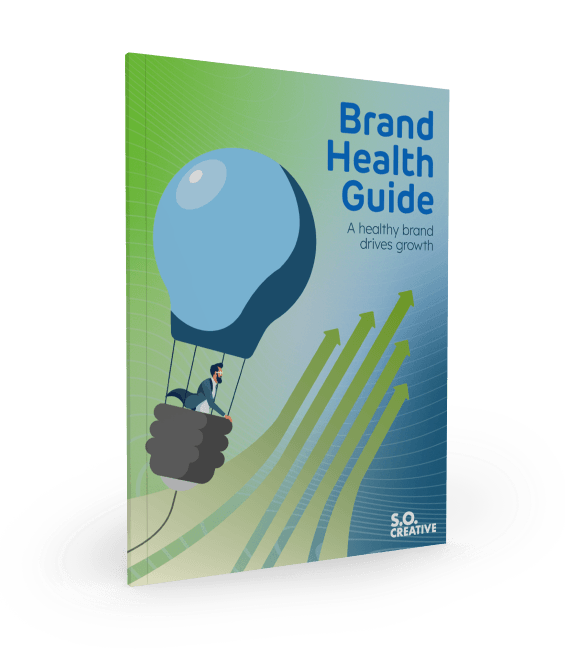Branding today is more than just a name and symbol, building a brand has evolved into a more complex and important matter when it comes to delivering a company’s message. But before we go into the details, it’s important to get this out of the way first: Your company’s logo is extremely important. It’s a symbol for your company that your audience can quickly recognize. A logo is a tool to help communicate a brand and represent a brand. However, smart marketers know branding is much more than a logo.
So what is a brand?
Your brand is your promise and the value you deliver to customers and everyone who comes in contact with your brand. It’s a lot more than a logo or pretty colors or a font type. Instead, a brand is a collection of perceptions that live in the mind of the customer. It’s a relationship, a connection and an inspiration. At its core, your brand is who you are and how you care about others.
A good brand communicates a clear message about what it stands for and how it differs from competitors. Each touchpoint in the customer experience should reinforce this same message. When it’s developed correctly, a good brand almost works like a belief system and takes on a life of its own. Ultimately, customers will stand behind the brand, adopt its vision and start being brand ambassadors, too.
Common characteristics of successful brands
Successful brands share common characteristics. For example, the best brands have a thorough understanding of the demographics of their target market, what their interests are and how they communicate. They all have a passion that makes them work hard and continually deliver greatness. They are consistent in the experience they offer and strive to go above and beyond consumer expectations. And they thrive on competition while constantly aiming to improve.
Does your brand have a real purpose?
They may not be aware of it, but customers are looking for something — a value or a stand — that they have in common with your brand. That’s why successful brands have a purpose and exist for a good reason. People today have a lot of choices regarding where to spend their money, and, many times, the only thing that may differentiate you from competitors is your sense of mission. People need something to connect with. Which means, your purpose should be clear and easy to understand.
Branding takes time, energy, thoughtfulness and a little bit of patience. In the branding process, you want to poke and prod until you get to the core of the brand. Then, get busy articulating your brand’s messaging and creating your brand’s look and feel. The five steps below will outline clearly what is needed to start the branding process.

Information gathering
The branding process begins with a meeting of the key stakeholders where branding participants delve into where your brand currently stands in the market and how customers perceive you. You’ll want to share any PowerPoint presentations, creative briefs, business plans and any other supporting documentation that would help explain and convey your marketing objectives. At this point, your branding agency should really be there to listen, gather information and ask lots of questions. Remember: The more information your branding agency has about you, the better equipped it will be to position or reposition your brand.
Research & discovery
R&D is crucial to building the foundation of your brand. In this stage, your branding agency learns everything it can about your brand. This research helps create a brand persona and a comprehensive picture of what your brand truly stands for. To do this, questions about your primary audience, as well as your secondary and even tertiary audience, are covered. It’s critical to understand what your audiences are looking for, what they value and what their pain points are in order to accurately position your brand. For the internal team, your branding agency should develop a detailed questionnaire covering various aspects of the brand, from brand values and character to future positioning.
The R&D stage requires a fair amount of research, including conversations and surveys with:
- Employees
- Higher-Ups
- Customers
Brand theme
Getting to your brand’s position requires some deep digging in order to define the end benefit and the true value proposition so that the branding is relevant and timeless. After defining the value proposition, work begins on a central brand theme or big idea that will resonate throughout the brand communication. Typically, the theme isn’t based on a brand’s products or services but, instead, how a brand delivers those products and services.
Articulating the brand
Now that you know your central theme, how do you want to convey that message? Do you want to sound bold and innovative? Do you want to educate and inform? What is the personality/tone of your brand? What tone of messaging will appeal most to your audience? These questions all need to be asked and then answered in a messaging document for your team to share and discuss.
Implementing the new brand
With the central theme and key messaging done, it’s time to develop the right visual approach that supports the brand and implement it across various media. To ensure consistent execution over time and protect your new visual identity system, you’ll want to develop a set of comprehensive identity standards and detail those standards in a Brand Guidelines document that is accessible to anyone and everyone who is involved in communications for your brand. Sure, it’s a lot of work to brand a company. But when done methodically and creatively, the payback is well worth the effort.
Remember: To capture the attention of customers, you need a rock-solid brand that stands out from the competition. That involves building your brand messages, brand personality, brand differentiators and brand visual identity — and your logo can play a key role. Your logo can help your company stand out from a visual perspective, so it has to look modernized and adequate for the type of business you’re in. Although the logo is important, changing it doesn’t necessarily mean you’ve rebranded your company.
Brand Development and Integrated Marketing
At S.O. CREATIVE, our specialty is brand development and integrated marketing communications for B2B industries. Connect with us today and let’s talk ideas that drive business!

